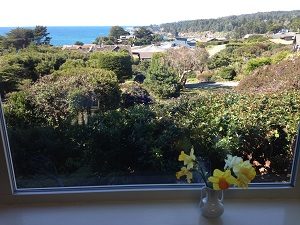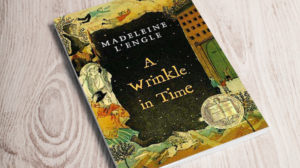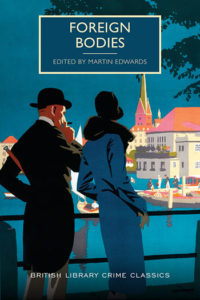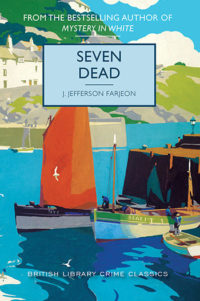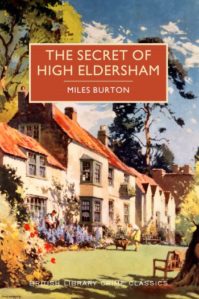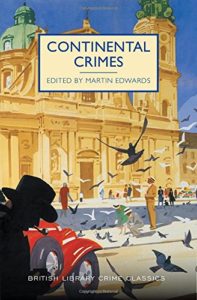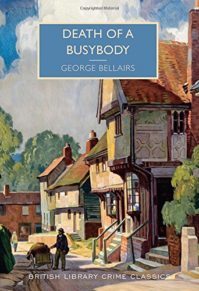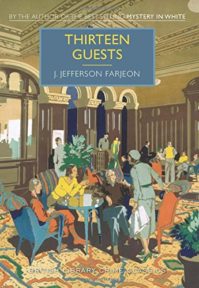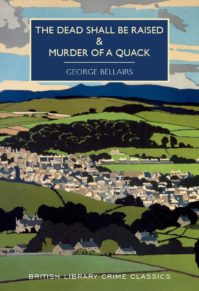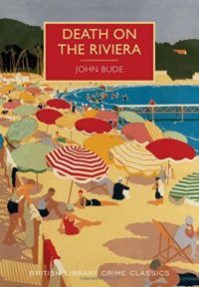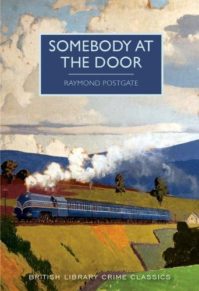Italian Fever by Valerie Martin
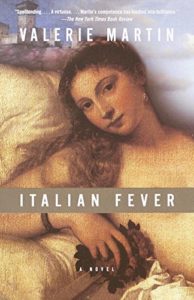 Back in January, I tended my yearly ritual of cleaning out my books. Not a task for the faint of heart, as it involves days of books stacked on the floors of various rooms, books teetering off my bedside table, and overflowing bags destined for donation to the library. I always end up with a pile of books on probation ~~ books I want to peruse a bit before deciding their fate.
Back in January, I tended my yearly ritual of cleaning out my books. Not a task for the faint of heart, as it involves days of books stacked on the floors of various rooms, books teetering off my bedside table, and overflowing bags destined for donation to the library. I always end up with a pile of books on probation ~~ books I want to peruse a bit before deciding their fate.
Italian Fever made its way into this probation pile and I don’t remember where I got it, but I did remember why. It reminded of some of my favorite novels that transported me to the warm and beautiful Italian countryside – Summer’s Lease by John Mortimer, The Enchanted April, and of course, A Room With a View.
So one rainy night, I opened Italian Fever to determine its destiny. While the novel wasn’t up to the caliber of the fore-mentioned novels, it did hold my interest and did envelope me in the atmosphere of the hot, sunny Tuscan countryside.
Our main character is Lucy, who is a New York based assistant to the famous US novelist, now based in Italy. She harbors a deep resentment of DV’s success, despite his mediocre writing, but her role has always been to coddle him along to finished manuscripts. However, as we learn in the prologue, DV has died while walking at night and Lucy is sent to Italy to settle his affairs — including retrieving his latest potential blockbuster manuscript.
When viewing the photos of his body, Lucy notes signs that he may have been beaten to death. Near his house in Tuscany she encounters a faintly sinister family of aristocrats: the elegant Antonio, his mother, his fiery but elderly father. Lucy seeks evidence of their involvement in DV’s death and the disappearance of his lover Catherine. The local police are typically holding something back and not aiding in any further investigations.
At first, I thought Ms. Martin was giving us a typical amateur sleuth solving a crime in a foreign land — but no, not really. There are surprising, but sometimes flimsy tangents in Italian Fever –as it twists from a mystery, into the Gothic, turns romantic adventure, with a bit of art history and, finally, a underlying ghost story.
The setting provides a beautiful backdrop to this unconventional story line, and for a few hours on that rainy night I was vicariously driving round the Tuscan countryside, window shopping in Rome, and gazing at Piero della Francesca’s fresco, The Resurrection.
Lucy winds up getting ill and the descriptions of being sick in a foreign country are some of the best passages in the novel. Her fever brings on bad dreams and disorientation which leads her to believe she is hearing ghosts and crimes being plotted.
Upon her recovery, Lucy, who has a sharp sense of humor, but lousy taste in men, allows herself to be taken in by the cliched Italian lover, Massimo — ignoring the much finer Antonio Cini. There’s some hot romance and a stereotypical break up.
Much more is discovered about DV, his death, the missing manuscript, Catherine — and I kept expecting a thrilling climax but alas, it did not transpire. Having traveled along the many twisty roads of the plot, I didn’t find any depth of drama or suspense.
As I turned the last page of Italian Fever, I decided that, yes, for a few house, I’d taken a pleasant journey to Italy with some beautiful sights, met some interesting characters, but nothing really memorable happened.
A myriad of memorable memoirs
Since the beginning of the year, I’ve read several very different memoirs. Unlike novels, I’m tough on memoirs — they must grab my interest almost immediately. I find if a memoir is boring or uninteresting, then so is the the author. Yes, I’m that brutal.
However, I found each of these memoirs engaging from the first pages, despite their widely differing approaches and themes.
________________________________________________
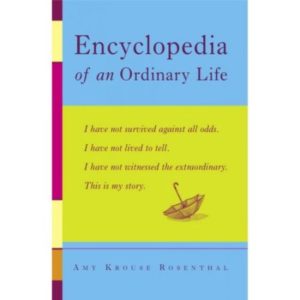 Encyclopedia of an Ordinary Life
Encyclopedia of an Ordinary Life
by Amy Krouse Rosenthal
I heard about this book on NPR and filed it away in my mental list of books I may want to read — someday. Then a friend raved about it and gave me her copy.
I was instantly laughing in my tea at the opening “Reader’s Agreement”. In this agreement (with spaces for you to sign and date), Ms. Rosenthal has a range of requests — from agreeing to refrain from taking on your cellphone while working out to giving her your credit card number so she can shop to her heart’s content at Anthropologie.
The book is called an “encyclopedia” because it chronicles the small moments of her ordinary life in an alphabetical, short-entry structure.
She has collected thoughts, observations, and decisions to create an alphabetized personal encyclopedia, complete with cross-referenced entries and illustrations. Like this…
Ms. Rosenthal reveals the minutiae of her life, from pumping gas:
Every. Single. Solitary. Time I go to get gas I have to lean out the window to see which side the tank is on.
to toast:
I cannot stress this enough: One second your toast is fine, golden brown: the next second it is black.
But then she stops the reader cold with a profound and insightful observation. There’s a touching entry on her need to complete things quickly to get them over with – eating dinner, when she’s out she wants to be home, etc.. She laments on how she can’t experience the full pleasure of an act or task until she has crossed it off her list.
Each entry reads like a short story – witty, sad, insightful and peculiar…many very peculiar.
There are some entries I found mundane and the part showing her high school yearbook signatures I found just plain boring, but then I perked up with this:
In most cases, it is more satisfying to get a friend’s answering machine and leave a cheery, tangible trace of your sincere commitment to the friendship than it is to engage in actual conversation.
There’s a section on how she contested a parking ticket on the grounds of Karma, complete with photocopies of the paperwork she submitted and the check she wrote for the 25 cents she should have put in the meter. Spoiler alert – she won.
Yes, this really is an encyclopedia of the author’s life – her hopes and dreams, childhood experiences, loves and hates, daily routine. It’s the sort of thing you can pick up and dip into to relate, laugh and even ponder — perhaps just as the author wanted.
Sadly, Ms. Rosenthal died of cancer in 2017 and she wrote “You May Want to Marry My Husband,”http://nyti.ms/2mFk0fE in her final days, some wonderful, but heartbreaking, writing
As one reviewer on the book jacket says:
An ordinary life, perhaps, but an extraordinary book.
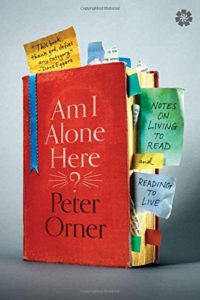 Am I Alone Here?
Am I Alone Here?
by Peter Orner
This wins the most unconventional award, as it’s described as “a book of unlearned meditations that stumbles into memoir.” (Say what?)
Mr. Orner, a professor, poses questions on literature and life and the reader is invited into this, at times, existential exploration. At first blush the book appears pedantic, but have courage readers, Am I Alone Here? is affecting on so many levels.
The author’s true love is the short story, mixed with poetry and the occasional novel. Each chapter shows a rendering of the book cover, reviews the story (or poetry), gives background on the author (many of which were unknown to me) and then, how the story relates to Mr. Orner’s own life.
Mr. Orner is a thinker — a ponderer and as with many artists he struggles with the meaning of his life as it relates to his gift…and gifted he is. There’s some staggeringly beautiful writing on display here.
On reading a book of poetry by an obscure poet:
Books pursue us. I’ve always believed this. I dug Herbert Morris out of the free bin outside Dog Eared Books (San Francisco). What compelled me to stop that day? How can I express my gratitude to a poet who never sought it, who only wanted me to know his creations, not their creator? An how many others might be out there, somewhere, under all this noise, tell us things we need to hear?
I must admit I skipped around while reading Am I Alone Here? and found some bits more interesting than others. The format is unusual which allows for picking and choosing chapters to suit. And the chapter titles — so intriguing:
Euroda Welty, Badass; Shameless Impostors; Surviving the Lives We Have; My Father’s Gloves; Night Train to Split: Unforgiveable
Don’t you just want to see what they’ll offer? My Father’s Gloves is a tender tribute to his father and, unless you’re a hard case, will bring tears to your eyes.
Sometimes heavy, often cynical, but always probing, and insightful– Am I Alone Here offers plenty to think about long after you’ve finished. An as an added bonus, if you’re like me, you’ll come away with a whole new list of authors and poets to explore.
_________________________________________________
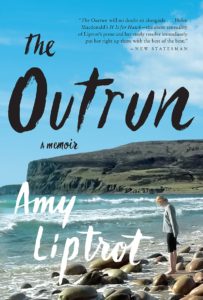 The Outrun
The Outrun
by Amy Liptrot
Amy Liptrot has returned to her childhood farm in Scotland’s remote Orkney islands, after suffering a horribly-gone-wrong life in London.
Her London life spirals out of control as she falls deep into alcoholism. She finally agrees to rehab (national health funded) and slowly works herself out of her addiction.
When I first left Orkney, my friend Sean gave me a compass. I used to wear it round my neck at parties, and when people asked about it, I would tell them it was so I could find my way home. I left the compass somewhere one night, then I was totally lost.
But go home she does. To her family farm on Orkney with a large coastal grazing area called an “outrun”. Slowly she adjusts to a gentler, slower life — sans alcohol and discovers an new equilibrium.
Eventually, Ms. Liptrot ends up on the even smaller island of Papay, population 70. She gets a job working for the RSPCA counting corncrakes (an endangered ground bird) as well as puffins and arctic terns. Her new life opens her eyes to the healing power of nature.
She joins the local swim club and finds that breath shattering cold sea swims are a new way of getting the high formally gained from drinking. (See me shivering as I write this.)
Ms. Liptrot re-discovers an interest in astronomy, as the island is one of the best places to see the stars with almost no light pollution and there are the occasional glimpses of the Northern Lights.
I’ve swapped disco lights for celestial lights but I’m still surrounded by dancers. I am orbited by sixty-seven moons.
There is a memorable passage about the rare and beautiful noctilucent clouds. These clouds are invisible most of the year, but in the summer, in this far northern latitude, they catch the sun’s rays in the last stages of twilight, as the ground grows dark. Then they burst into brilliant colors.
The first half of The Outrun was beautiful and fascinating, but by the second half, it became repetitive with the author’s “self help” observations. I must admit I skipped over much of the latter half of the book — but greatly appreciated the totality of the work.
Ms. Liptrot is an exquisite chronicler of island life so near the Arctic Circle, with starkly beautiful passages on island life, sunsets, waves and even shipwrecks
The Outrun is a brave memoir, unvarnished and beautifully written. I closed the book picturing the author living her life — strong and clean:
I stride onwards… I am a lone figure in waterproofs walking the coastline, morning after morning, miles from anywhere, at the north of nowhere. But down here, inside myself, I feel powerful and determined.
A digital review copy was provided by W. W. Norton & Company via NetGalley
________________________________________________
The New Old Me 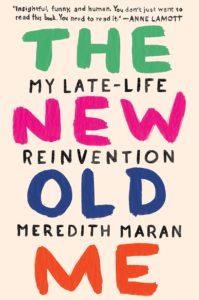
My Late Life Reinvention
by Meredith Maran
We’ll end this myriad of memoirs on a lighter note — this unexpectedly funny and uplifting memoir. From the cover blurb
Maran writes “a poignant story, a funny story, a moving story, and above all an American story of what it means to be a woman of a certain age in our time” (Christina Baker Kline)
Meredith Maran’s marriage has dissolved, her Victorian house on the edge of Berkeley lies empty, and her free-lance writing life is in shambles – so what does she do? She accepts a full time writing job at a start up firm in Los Angeles. And thus begins one woman’s story of starting over at 60 in youth-and beauty obsessed Hollywood.
One can imagine moving to a new city, making new friends, trying to find love while in your twenties, but Ms. Maran makes this move in her sixties.
She’s alone, missing her friends, her estranged wife (yes Ms. Maran is gay), her family (yes she has children from a previous heterosexual marriage) and terror-struck at having to work with millennials (remember she’s 60 – a very good looking 60 — but still it’s that number 6-0, a great distance from the twenties).
We ride along as she finds a cute and somehow affordable apartment in Los Angeles, granted it overlooks a convenience store air conditioning unit, but its hers and we delight as she decorates it from found objects and little bits from here and there. But still there’s still the bittersweet-ness of being alone:
Biggest. Surprise. Ever. That cheery feminist crap is true. For the first time since childhood, I’m responsible to no one. I can be Helena’s girlfriend or break with her without upsetting my kids or my own living situation or my finances. I can make money or rest on whatever laurels I’ve got without depriving anyone of anything. I can binge-watch Girls till midnight or go to sleep at nine. The bad news and the good news is the same. I have nothing and no one to lose.
Ms. Maran does make friends, discovers joy walking in the hills, and eventually goes on dates – once with a man, which turns into a teeth clenching experience for both her and the reader alike.
She faces death in quick succession, her best friend back in the Bay Area and then her father. During the trips back, she sells her house, finalizes her divorce, and rids herself of belongings from her her former life. A roller coaster ride of emotions which Ms. Maran somehow makes both funny and heartbreaking.
Once in awhile a writer’s voice will enchant a reader and Ms. Maran does just that. She twists what is actually heartbreaking loss into a story of resilience, love and humor. She never takes herself too seriously and her story of re-invention, re-discovery, and recovery is told with grace, wit and compassion. I adored this memoir.
Mendocino Sojourn
We took a few days up in Mendocino, a very favorite spot of ours.
We were able to arrange a home exchange with a house right in Mendocino village. Extraordinary to be able to walk right out the back door, then around the village, wander the headlands, and best of all seeing whales migrating.
With apologies to the snow-bound … here are some photos. If it makes you feel any better it was windy, at times rainy, and chilly.
- View from front window
- View from front garden
Our exchange house — sigh.
Went to visit this lighthouse after enjoying it flashing through our windows at night….
We wandered around the headlands —
One evening, at the suggestion of our home exchange partners, we went to see a Neil Simon play, Rumors at the Mendocino Playhouse – a cute 75-seat theater and a fun play. One of the actors was our wine tasting host at Baxter winery where stopped the day before.
Small town, small village, everyone knows everyone.
A wonderful few days.
For my fellow Murder She Wrote geeks fans.
Here’s Jessica’s house aka Blair House.
I was filled with thoughts of moving here ~~
Does anyone else ever imagine living full time in a place they visit?
Once I stole a book…
It’s Throwback Thursday, when I rave about a book I read years ago.
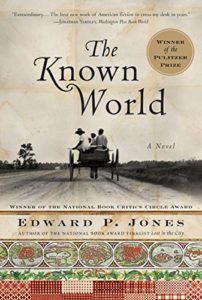 The Known World
The Known World
by Edward P. Jones
Once dear readers, I accidentally stole a book. Stuck in an airport in 2004, I was of course browsing in the book store, magazine in one hand, this hefty paperback in the other. I panicked when my long delayed flight was suddenly announced and quickly paid the cashier for the magazine, both of us oblivious to the book under my arm. As I galloped to the gate, I mindlessly tossed the book in my bag. Once I got on the plane, and looked at my receipt I realized the error of my ways. I tempered my guilt by recounting the money I’d spent at this book chain (they have since gone out of business, probably due to thievery like mine).
Turns out this lucre kept me fascinated for the entire cross country flight. I barely looked up when the food was served. (Just imagine, once even coach passengers were served a meal on cross country plane trips.)
This Pulitzer Prize winning novel centers on a family of free blacks who run a plantation in pre-Civil War Virginia. The Southern slave culture was so deeply embedded, that it was not considered odd (or even ironic) when freed blacks became slave holders themselves; a little know part of American history.
Henry Townsend is a young black man living in Virginia 20 years before the Civil War — a free son of parents who were freed slaves. His father, a skilled woodworker, holds strong convictions regarding the evils of slavery. But Henry grows up to idolize a white plantation owner and the most powerful slave-owner in the county. Much to his father’s horror, Henry purchases his own plantation and keeps black slaves. When Henry dies unexpectedly, his widow Caldonia struggles to hang on to his legacy, but things start to unravel as the plantation slaves start to break the bonds of their servitude.
These slaves (like some others of the time) were able to buy their freedom by working in off-the-plantation enterprises such as builders, artisans, and agronomists which allowed them to earn cash. They could then pay for their own freedom as well as the price demanded for their wives and children (at full market value no less) .
The Known World is unique and some thought it a difficult read. The novel is not chronological, but follows thematic arcs, often going back and forth in time and recounting different versions of the story line. I didn’t find it confusing — I enjoyed being told a riveting story from several different points of view. Mr. Jones has provided a handy list of the numerous characters in the back of the book, but I never needed it. Somehow each of the many characters are richly rendered and fleshed out. Each character had a fine-tuned personality and it was easy to keep them separate, as I got to know each so well.
“The Known World” is an apt title, as it represents the limiting life of a few plantations which comprised the entire world for the slaves. One master may sell a slave to a nearby neighbor; another one is freed and moves in close proximity to his former master, so that their universe rarely grew larger. Even traveling on an errand from one neighbor to another, or from the plantation to town, required the written permission of the owner.
I can understand why Mr. Jones won the Pulitzer for this novel. His ear for dialog, eye for detail and command of the language was a joy to this reader, against the bleak backdrop of slavery and the grim ways in which power/greed so easily corrupt.
I highly recommend The Known World, filled with rich stories and a sense of place so real, so honest – you’ll find it difficult to believe you’re reading fiction.
A copy of this novel was unknowingly provided by a large anonymous book chain, which has since gone out of business.
A Wrinkle in Time by Madeleine L’Engle
When I was growing up in the suburbs of Washington D.C. I was allowed to go to my neighborhood library on my own ~~ an often needed escape from my younger siblings. I adored the Aspen Hill Library and would wander the shelves, library card itching in my pocket.
I often visited the popular YA (young adult) shelves, but never really understood the appeal coming from home with Little Women, Black Beauty and Little House on the Prairie at my disposal. I tried and dismissed Judy Blume, V. C. Andrews, and the insipid Beverly Cleary series (see I was a critic even back then).
But there was one YA book I checked out over and over again.
A Wrinkle in Time by Madeleine L’Engle opens with the classic line…
It was a dark and stormy night…
Published in 1962, this Newbery Medal classic is part science fiction, part time travel tale and I was mesmerized. I could easily relate to Meg who doesn’t fit in at school and going through an awkward stage with unruly hair and braces.
Meg’s father has disappeared during a scientific trip and she, her little brother, and family friend Calvin are whisked away to find him. Three strange women with mysterious talents help them follow their quest – Mrs. Which, Mrs. Who and Mrs. Whatsit. And the reader is off on an adventure like no other.
Back in the 60’s, as I read this book over and over again, the appeal was not only the riveting story, but the intelligent way it spoke to young readers — with quotes from Latin, complicated mathematical and scientific theories — but also the respect and self-confidence it gave girls (and boys). Meg is shown how to be herself and reassured that it is a good thing to be different from anyone else. She is called upon to be brave beyond her wildest dreams, survive different species, experience new cultures, and use her brain to overcome obstacles. In other words — everything I wanted to be and do.
Ms. L’Engle wrote A Wrinkle in Time in the shadow of the cold war and upon re-reading this wonderful story, I now see the obvious references that mirror the 1960’s fear of communism — over my head at age 10.
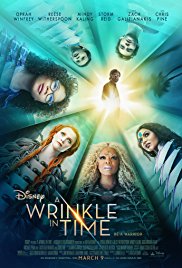 A Wrinkle in Time has been made into a Disney film which opens today. It stars Reese Witherspoon, Oprah Winfrey and other big names. It might actually be good, and now that I’ve just re-read the book, I can give myself permission to go see it.
A Wrinkle in Time has been made into a Disney film which opens today. It stars Reese Witherspoon, Oprah Winfrey and other big names. It might actually be good, and now that I’ve just re-read the book, I can give myself permission to go see it.
If you haven’t read A Wrinkle in Time lately, I suggest you re-read it.
If you’re like me you’ll not only enjoy the adventure once again — but have a new admiration for how it influenced young readers to be bold, fearless, but mostly to have confidence in always being themselves.
Film Trailer HERE
The British Library Crime Series
Is it possible to have a crush on a publisher?
My heart beats faster, my fingers fondle their book covers, and my wallet giddily opens its arms — all for The British Library Crime Series by Poisoned Pen Press.
Just look at these beauties, I mean really, what mystery reader could resist?
I first became aware of this series with my first purchase of THIS long lost favorite mystery. Since then I have cultivated a insatiable craving finely-tuned taste for this Poisoned Pen Press imprint.
In 1997, husband and wife founders, Robert Rosenwald and Barbara Peters, who are also the owners of the legendary Poisoned Pen Bookstore in Scottsdale, Arizona, saw an opportunity to re-publish the wonderful British mysteries novels of the 1930’s and 1940’s. They tapped into every bibliophile’s secret desire –out of print titles, long lost authors, and beautiful covers to lovingly add to a bookcase:
“We knew that mystery readers wanted complete collections, so we thought we could make a business out of that.”
I’ve read several of these and, while some are better than others, all are well-plotted mysteries graced with some classic crime writing and completely interesting settings – in short they are pure fun escape reading.
There are locked room mysteries (Miraculous Mysteries), murders in Europe (Continental Crimes), small village settings (Death of a Busybody), and dead bodies in crumbling manors (Seven Dead).
In short, there’s a British mystery for you in The British Library Crime Series. You got to love any publisher/bookseller who states this as their mission statement:
We are a community Bound By Mystery.
and who gathers praise such as this:
Hurrah to British Library Crime Classics for rediscovering some of the forgotten gems of the Golden Age of British crime writing.(Globe and Mail)
Might I suggest you support this fine enterprise by buying the books direct from their website ~ just click this logo.
Thanks to Poisoned Pen Press for allowing me advanced copies of many of these titles via NetGalley.
How to Stop Time by Matt Haig
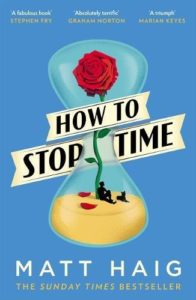 What, you say? Not another time travel novel here at Book Barmy?
What, you say? Not another time travel novel here at Book Barmy?
Maybe or maybe not – stick with me here, this one is different.
In How to Stop Time, Mr. Haig has conjured up a unique spin on the typical time travel novel — namely a tale centered around the ability (or curse) to live a very, very long time.
Tom Hazard, (full name Estienne Thomas Ambroise Christophe Hazard) was born in 1599 and suffers from a rare genetic condition that makes him age very slowly. He has been alive for the last 400 or more years. The book opens with this wonderful first line:
I am old. That is the first thing to tell you. The thing you are least likely to believe.
Over the centuries, Tom has lived many lives and because of his longevity, many of those lives were filled with love, but also heartbreak and loss.
On the positive side Tom got to work at the Globe Theatre with William Shakespeare, rubbed elbows with F. Scott Fitzgerald, and sailed with Captain Cook, all while avoiding anyone who grows suspicious of his glacial aging process.
Tom is recruited into the Albatross Society which pledges to protect people with his disease. The only stipulation is that he has to change lives every eight years and he is given this warning:
“The first rule is that you don’t fall in love,” he said… “There are other rules too, but that is the main one. No falling in love. No staying in love. No daydreaming of love. If you stick to this you will just about be okay”.
In an effort to make up for the no love rule, Tom is reassured:
“You are, of course, allowed to love food and music and champagne and rare sunny afternoons in October. You can love the sight of waterfalls and the smell of old books, but the love of people is off limits.”
But all Tom wants is to live a normal life and find his long lost daughter who also suffers from the same genetic condition. When the book opens, Tom has settled into teaching at a London high school, and of course he chooses to teach history, because:
It [history] isn’t something you need to bring alive, because it already is alive. Everything we say, do and see is only because of what has gone before.
He adopts a dog and finds himself attracted to the French teacher Camille, but he must resist because of the society rules. Soon it is time to take on another persona, and move on to yet another life and another adventure.
That’s all the plot I’ll give away from this engrossing tale.
Mr. Haig transports the reader back and forth in history. But, he doesn’t beautify — instead he unveils the filthy, muddy, smelly reality of earlier times. We see Shakespeare writing his beautiful works against the backdrop of crime, bigotry and disease. Tom plays the lute in the marketplace right beside animal filth. Everyone drinks ale, because the water might kill you.
For me the most interesting part of How to Stop Time, was the irrationality of the human experience. People throughout history have always hurt others, made stupid mistakes, been egocentric, and continue to do so — over and over and over again. And important note, we haven’t become wiser over time:
The lesson is that ignorance and superstition are things that can rise up, inside almost anyone, at any moment. And what starts as a doubt in a mind can swiftly become an act in the world.
Which brings one to ponder long after the last page. How would you live — how would you act — and mostly how would you feel — knowing you could live almost forever?
How to Stop Time is handsomely written and filled with the bittersweet truth of the human experience — our capacity to endure pain, inflict hurt, but also our ability to love beyond any limits, even those of time. All while carelessly bumbling through our ever-so-short lifespans.
A digital review copy was provided by Viking via Net Galley.



